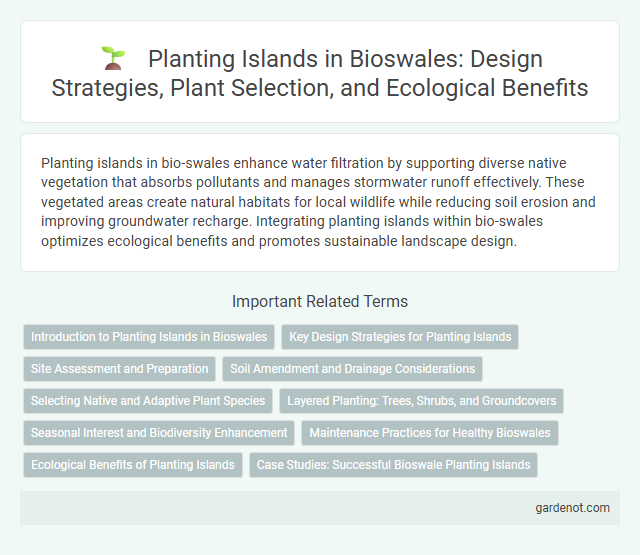Planting islands in bio-swales enhance water filtration by supporting diverse native vegetation that absorbs pollutants and manages stormwater runoff effectively. These vegetated areas create natural habitats for local wildlife while reducing soil erosion and improving groundwater recharge. Integrating planting islands within bio-swales optimizes ecological benefits and promotes sustainable landscape design.
Introduction to Planting Islands in Bioswales
Planting islands in bioswales serve as vegetated areas designed to enhance stormwater management by capturing and filtering runoff through deep-rooted native plants. These islands improve soil infiltration, reduce pollutants, and promote groundwater recharge by supporting diverse plant species adapted to fluctuating moisture conditions. Incorporating planting islands enhances the ecological function and aesthetic value of bioswales in urban landscapes.
Key Design Strategies for Planting Islands
Planting islands in bio-swales leverage native, deep-rooted vegetation to enhance infiltration and pollutant filtration, effectively reducing stormwater runoff. Strategic selection of drought-tolerant and moisture-loving species ensures adaptability to fluctuating water levels, while layering plants in a multi-tiered arrangement maximizes soil stabilization and promotes biodiversity. Incorporating permeable soil mixes and organic mulch aids in moisture retention and supports microbial activity vital for nutrient cycling within the planting island ecosystem.
Site Assessment and Preparation
Site assessment for planting islands in bio-swales involves evaluating soil composition, drainage patterns, and sunlight exposure to ensure optimal plant growth and pollutant filtration. Preparation includes removing existing vegetation, amending soil with organic matter, and grading the area to direct stormwater flow effectively. Proper site assessment and preparation enhance the bio-swale's ability to manage runoff and support native, water-tolerant plant species.
Soil Amendment and Drainage Considerations
Planting islands in bio-swales require carefully selected soil amendments to enhance nutrient retention and support healthy vegetation growth. Incorporating organic matter such as compost improves soil structure, increases porosity, and promotes beneficial microbial activity critical for pollutant breakdown. Proper drainage design ensures adequate infiltration rates while preventing waterlogging, which can compromise root oxygenation and reduce bio-swale efficiency.
Selecting Native and Adaptive Plant Species
Selecting native and adaptive plant species for planting islands enhances bio-swale efficiency by improving water infiltration and pollutant removal. Native plants, well-suited to local soil and climate conditions, require less maintenance and provide habitat for local wildlife. Adaptive species increase resilience to fluctuating moisture levels and seasonal changes, ensuring long-term functionality and ecological balance.
Layered Planting: Trees, Shrubs, and Groundcovers
Layered planting in bio-swale islands involves strategically placing trees, shrubs, and groundcovers to enhance stormwater filtration and prevent erosion. Trees provide shade and stabilize soil with deep roots, while shrubs improve water absorption and nutrient uptake through mid-level root systems. Groundcovers create a dense mat that reduces surface runoff and protects soil from compaction, supporting overall ecosystem health.
Seasonal Interest and Biodiversity Enhancement
Planting islands in bio-swales maximize seasonal interest by incorporating a diverse range of native perennials, grasses, and flowering species that bloom at different times of the year. These plantings support local biodiversity by providing habitat and food sources for pollinators, birds, and beneficial insects throughout changing seasons. Strategic species selection promotes resilient ecosystems while enhancing the visual appeal and ecological function of bio-swale systems.
Maintenance Practices for Healthy Bioswales
Consistent pruning and removal of invasive species in planting islands are essential to sustaining healthy bioswales by promoting native plant growth and improving water filtration efficiency. Regular inspection for erosion or sediment buildup allows timely restoration efforts, preventing clogging and maintaining optimal stormwater flow. Incorporating mulch and ensuring proper irrigation further enhance soil moisture retention, supporting robust vegetation and long-term bioswale performance.
Ecological Benefits of Planting Islands
Planting islands within bio-swales improve stormwater management by enhancing soil infiltration and reducing surface runoff, which minimizes erosion and water pollution. These vegetated areas provide essential habitats for beneficial insects and wildlife, promoting biodiversity in urban environments. The deep-rooted plants stabilize the soil, increase organic matter, and support microbial activity that aids in breaking down pollutants naturally.
Case Studies: Successful Bioswale Planting Islands
Bioswale planting islands in urban environments have demonstrated significant improvements in stormwater filtration and pollutant removal by using native vegetation such as sedges, rushes, and wildflowers. Case studies, like the Portland Ecoroof Project, reveal enhanced water retention and reduced runoff, contributing to urban heat island mitigation and habitat creation. These planting islands also foster biodiversity and improve aesthetic value while requiring minimal maintenance.
Planting island Infographic

 gardenot.com
gardenot.com